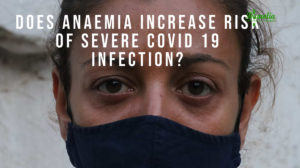Does Anaemia Increase Risk Of Severe Covid 19 Infection?

Half of India’s children and women are suffering from Anaemia. At Branolia our Kulerron team scoured through the available medical research and it seems to indicate that Anaemia is associated with an enhanced risk of severe COVID -19 infection.
Anaemia is the condition of having a lower-than-normal number of red blood cells or quantity of hemoglobin. It can make one feel tired, cold, dizzy, irritable and short of breath, among other symptoms. Medical research literature suggest three possible links between anaemia and severe COVID 19.
A. Impaired ability of the blood to carry oxygen leading to multi organ failure: Patients with anemia have low hemoglobin level in blood. Hemoglobin’s task is that of carrier for oxygen to target organs in the body. When the concentration of the hemoglobin in the circulation is low, the transport of oxygen to several organs in the body gets impaired, therefore causing hypoxia (Hypoxia is a condition in which the body or a region of the body is deprived of adequate oxygen supply at the tissue level) that eventually can result in multiple organ dysfunction, especially respiratory organ dysfunction. A previous study has shown that anemia was common in patients with community-acquired pneumonia (CAP) and was associated with a higher 90-day mortality rate (1). Multiple organ dysfunction will contribute to the development of severe outcomes in COVID-19 infection.
B. Viral-hemoglobin interaction can cause hemolysis: In COVID-19 infections, the state of anaemia in the patients can worsened. SARS-CoV-2 can interact with hemoglobin molecules on the erythrocyte through ACE2, CD147, and CD26 receptors. This viral-hemoglobin interaction can cause the virus to attack the heme on the 1-beta chain of haemoglobin causing hemolysis (2). Hemolysis is the destruction of red blood cells.
C. Precipitation of the cytokine storm: SARS-CoV-2 mimics the action of hepcidin(hepcidin is a key regulator of the entry of iron into the circulation in mammals). which impacts tissue ferritin (affecting liver, spleen, bone marrow, and muscles mainly), while inducing serum iron deficiency and lack of haemoglobin, by consequence. The resulting hyperferritinemia (elevated serum ferritin) will give rise to ferroptosis (type of cell death dependent on iron and characterized by the accumulation of lipid peroxides), with high oxidative stress and lipoperoxidation that can precipitate the inflammatory/immune over-response (cytokine storm) and causing a severe outcome of the disease(3).
What can anaemic patients do to minimise COVID 19 risk ?
While the research on anaemia and COVID 19 is in early stages, the initial results seem to point to adverse outcomes from the disease in Anaemia patients. It is therefore advised that persons with Anaemia should consult their health provider for minimising the risk from th disease. An early start is to have a diet which contain enough iron, folic acid or vitamin B12.
Ayurveda can help
Ayurveda has long known Kulekhara herb to be especially potent against anaemia. Branolia’s Kulerron packs the goodness of Kulekhara in the recommended proportion and is considered one of the best ayurvedic anaemia reducing medicine. The anaemia reducing Kulerron has helped thousands in increasing their haemoglobin count the natural way. Anaemia reducing action of Kulerron has no side effects. Also, it does not lead to constipation unlike most iron supplements.
Anaemia reducing Kulerron is manufactured in a GMP certified facility and has the assurance from Branolia, the 100 year old ayurvedic company from Bengal. We at Branolia remain committed to the national fight against Anaemia and COVID 19. We have extended the availability of Kulerron across the country through our online store (https://www.branoliachemicals.com/buy-now/).
Disclaimer: The blog post is based on the research published in accredited medical journals and literature review (4). No original medical research has been conducted by Branolia Chemical Works.
Reference:
1. Reade M.C., Weissfeld L., Angus D.C., Kellum J.A., Milbrandt E.B. The prevalence of anemia and its association with 90-day mortality in hospitalized community-acquired pneumonia. BMC Pulm Med. 2010;10:15. doi: 10.1186/1471-2466-10-15.
2. Hemauer S.J., Kingeter A.J., Han X., Shotwell M.S., Pandharipande P.P., Weavind L.M. Daily lowest hemoglobin and risk of organ dysfunctions in critically ill patients. Crit Care Med. 2017;45(5):e479–e484. doi: 10.1097/CCM.0000000000002288.
3. Cavezzi A., Troiani E., Corrao S. COVID-19: hemoglobin, iron, and hypoxia beyond inflammation. A narrative review. Clin Pract. 2020;10(2):1271. doi: 10.4081/cp.2020.1271.
4. Hariyanto T and Kurniawan A , Anemia is associated with severe coronavirus disease 2019 (COVID-19) infection, Transfus Apher Sci. 2020 Aug 28 : 102926. doi: 10.1016/j.transci.2020.102926 , [Epub ahead of print], Elsiver Public Health Emergency COVID-19 Initiative
[supsystic-social-sharing id="1"]

